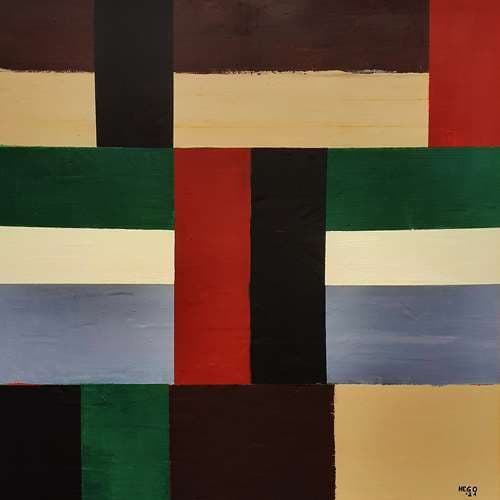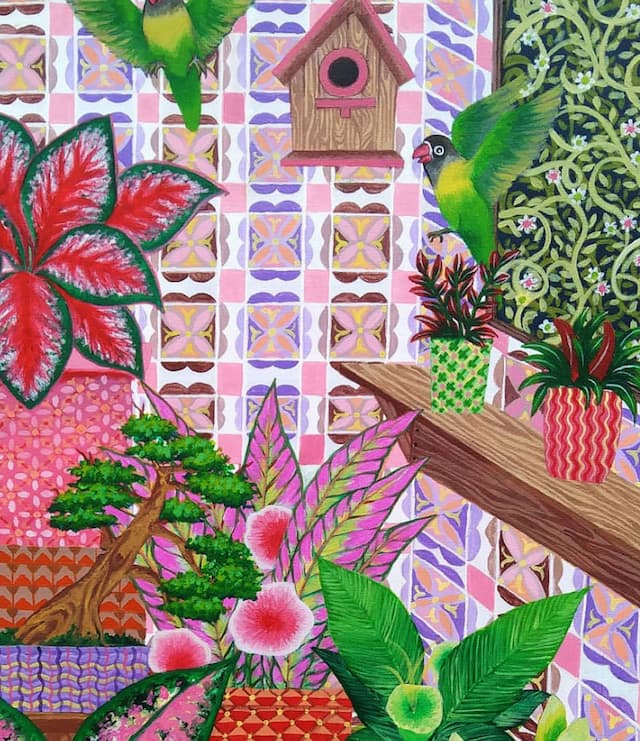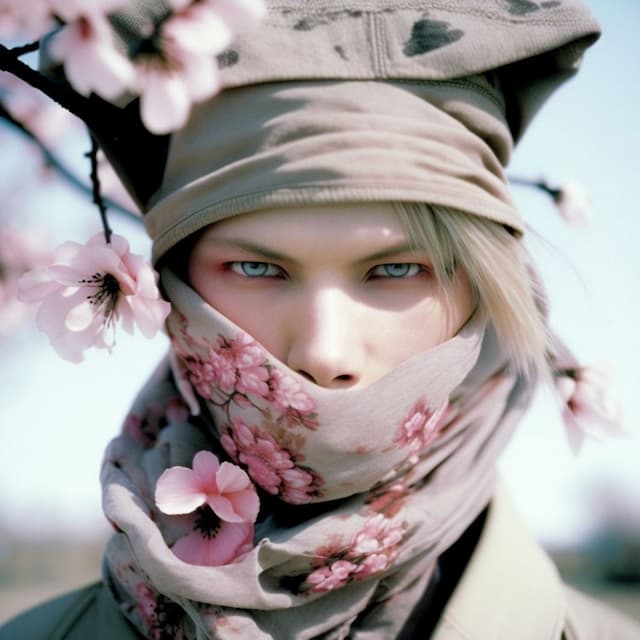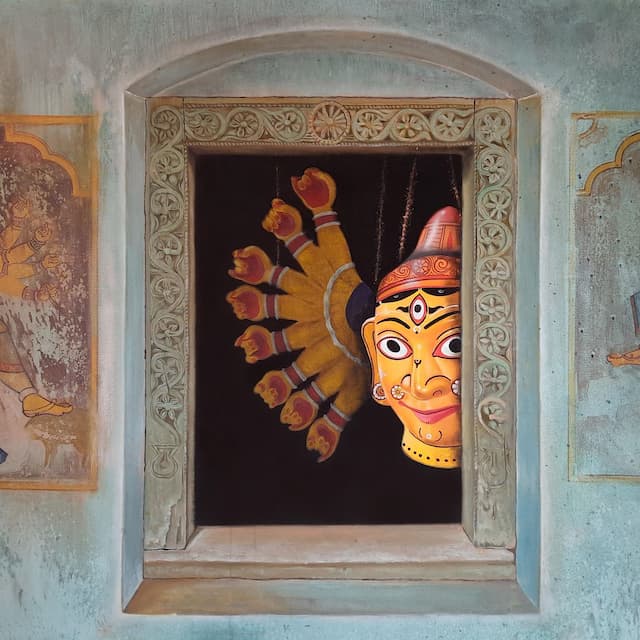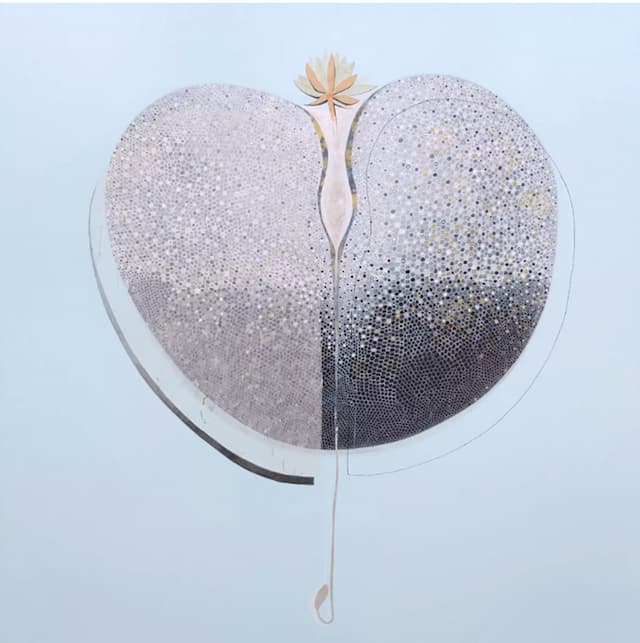Subscribe for our newsletter to have the latest stories and curated art recommendations delivered straight to your inbox
Raja Ravi Varma and Shakuntala
RtistiQ
 Like
Like comments
comments SAVE
SAVEThroughout the history of art, varied artistic reinterpretations of mythology have resulted in some of the most iconic works of art. Mythology resonated in the splendid Avalokiteshwara of Ajanta; Sandro Botticelli’s The Birth of Venus (1483-85); the cheap mass-produced Battala woodcuts; Picasso’s Minotaur Ravishing a Female Centaur (1933/39); MF Husain’s Mahabharata series (1971); and in some cases dominated entire repertoire of artists like Raja Ravi Varma. Known for his emblematic depictions of Hindu mythology, Raja Ravi Varma arrived at something that was never seen before - the archetypal Nayika or Heroine. With the use of oil paint and realism, Ravi Varma recreated the literary heroine as an empowered woman rather than a damsel in distress.
It wasn't so that every other mythological character found a place in Ravi Varma’s canvas, but only those
dramatic characters that had permeated into the Indian psyche over the centuries. Shakutala was one of many Nayikas that Ravi Varma resuscitated in a new avatar and it seems that she occupied a special place in the artist’s oeuvre. Kalidas’ eponymous heroine born to the great sage Vishwamitra and celestial nymph Menaka, Shakuntala’s life was full of trials and tribulations. Soon after her father and mother abandoned her, sage Kanva brought her up in his ashrama. As the story goes the sage found her in a forest amidst singing shakunta birds and named her Shakuntala. She later met Emperor Dushyanta of Hastinapur and married him only to be deserted by her husband in a forest while she was asleep. Their son Bharata, later became the emperor and the predecessor of the Kauravas and Pandavas. Her efforts to reunite with her husband is one of India’s most loved and much read literary saga retold in Mahabharata and Kalidas’ Abhijnanashakuntalam (The Recognition of Shakuntala).
Ravi Varma’s fascination with Shakuntala resulted in many memorable creations including the first chromolithograph “Birth of Shakuntala” (Shakuntala Janma; also bears the spelling 'Sakoontala') that came out of Ravi Varma Fine Art Lithographic Press in 1894. Other such timeless Raja Ravi Varma lithographic compositions featuring Shakuntala include Shakuntala Patralekhana, Shakuntala Dushyanta, Menaka Shakuntala, Shakuntala Removing a Thorn from Her Foot, Shakuntala Sakhi, and many others. One of the lithographs, titled Shakuntala Sakhi portrays a young Shakuntala in sylvan surroundings with her sakhis (friends) Anusuya and Priyamvada. Ravi Varma who captured in her many moods and many more life incidents gives us a glimpse of a young and playful Skauntala adorned in flowers with Anususya, Priyamvada and a deer. Shakuntala’s white drape clashes against Anusuya and Priyamvada’s bright red and yellow sarees, a familiar trope used by artists to depict the nayika/heroine’s purity. The scene symbolically juxtaposes Shakuntala’s naive innocence where her friends tend to her with the deer’s fickleness. Unaware of the life changing events, Shakuntala here is bliss personified.
Through his lithographic press, Ravi Varma also gave new meaning to the art of collecting and owning art. This pioneering step made it possible for the common man to own a piece of art produced by the incredible Raja Ravi Varma! Credited for many-a-firsts, Raja Ravi Varma was possibly the first Indian artist to master perspective and the use of oil paint; he also pioneered the use of human models to depict Hindu gods and goddesses and scenes and stories from Ramayana, Mahabharata, and the Puranas; the first Indian artist to gain widespread international fame at a time when painters and craftsmen largely remained either anonymous or unidentified; and the first to make his work available not just to a specific class of patrons but also to common people by way of his oleographs.
RtistiQ brings to you the Raja Ravi Varma Phygital NFT art auction that will be held between the 28th- 31st July’22.
Don’t miss out and collect them all by clicking here. https://art.rtistiq.com/en/auction/raja-ravi-varma-nft-drop2/lots

Ravi Varma, Birth of Shakuntala, circa 1894, Ravi Varma Press
Image courtesy: Google Arts & Culture; Raja Ravi Varma Heritage Foundation, Bengaluru

Ravi Varma, Shakuntala Patralekhan, 1895, Ravi Varma Press
Image courtesy: Google Arts & Culture; Raja Ravi Varma Heritage Foundation, Bengaluru

Raja Ravi Varma, Shakuntala Removing Thorn from Foot, 1898
Image courtesy: Google Arts & Culture; Raja Ravi Varma Heritage Foundation, Bengaluru

Ravi Varma, Menaka Shakuntala Sakhi, circa 1890, Ravi Varma Press
Image courtesy: Google Arts & Culture; Raja Ravi Varma Heritage Foundation, Bengaluru

Ravi Varma, Shakuntala Sakhi, circa 1890, Ravi Varma Press
Image courtesy: Google Arts & Culture; Raja Ravi Varma Heritage Foundation, Bengaluru
Explore our Curated Collections
SIMILAR ARTICLES

Mohini - A Raja Ravi Varma Lithograph
Raja Ravi Varma was one of the most celebrated artists of India in the 19th century. He was a popular and significant artist of the time, who combined European sensibilities with traditional Indian artistic landscape, thus carving a niche for himself. Raja Ravi Varma’s early life was spent in the tiny hamlet of Kilimanoor, around 40 km north of Trivandrum in Kerala. He was from a princely family, closely linked to the ruling family in Trivandrum. His family was creatively inclined and had a profound effect on the young Ravi Varma. His father was a Sanskrit scholar, and his mother was a poet. His uncle was an amateur artist, who painted in the Tanjore style. So, when Ravi Varma began to exhibit artistic inclinations, it was his uncle who encouraged him with his early lessons. He was a pioneer in the field of art, having successfully combined Indian iconography with western painting techniques. His prolific repertoire included paintings of Indian mythological figures, Gods, Goddesses, studio-style portraits of royalty, and scenes from everyday life. He was one of the earliest Indian artists to exhibit his paintings abroad. He was revolutionary in his contribution to the Indian art scene, having established a lithographic press so that his paintings become accessible to the common man. He was awarded the Kaiser-i-Hind, gold medal, for his service to the British Raj, in the year 1904. Even after a century, his work is still celebrated and sold for millions of dollars at the top art houses around the world. The lithograph Indian mythology is a veritable treasure trove of stories, filled with fantasy, adventure, heart wrenching tragedy, romance, and mystery. It is no wonder that the characters who populated these mythic legends have managed to capture the imagination of the people who read them. Being the extraordinary artist that he was, Raja Ravi Varma was successful in breathing a new life into these characters, by reimagining them and showing a rare human side to them, while transporting them to his wonderous paintings. The lithograph featured here is titled, Mohini, the temptress. It is based on the original oil painting by Ravi Varma, which was named, Mohini on a swing. This painting depicts, Mohini, the female form or avatar of Lord Vishnu, who features in the lore of yore. Mohini is mentioned in the puranas, as a seductress, enchanting and dazzling the demons with her beauty and beguiling them to concede and let the God’s taste the nectar of life first. The next time Lord Vishnu took Mohini’s avatar was to save Lord shiva from the clutches of the formidable and unvanquishable demon, Bhrahmasura. In this exquisite painting, Mohini is shown seated on a swing under a shade of a majestic tree. She is swathed in a white attire, presumably a saree, with a rich gold border and simple jewellery. The bangles and necklace seem to accentuate her delicate wrists and slender neck. Mohini is captured here in a rare, lighthearted moment, with her windswept hair trailing behind her and her feet in the air, as she attempts to swing higher. Image courtesy: Google Arts & Culture; Raja Ravi Varma Heritage Foundation, Bengaluru The scenic background, with Ravi Varma’s trademark artistic touches serves to accentuate the beauty of the painting. Ravi Varma as an artist often managed to cross the thin line between the real and the imaginary world, especially when it came to portraying women. He used many elements like richly decorated attire, jewellery, even flowers and fruits to accentuate the beauty of his muses and to bring out their mood in the painting. For instance, in his famous painting ‘Radha in the moonlight’, the nayika Radha, is seen sitting on the rocks, next to flowing water on which moonlight is reflected. The faint hint of smile and her gaze hints at the fact that she may have seen Krishna, approaching her. Her body language, the way her sari is pulled around her shoulders and her luminous beauty, reveal the fact that she is both a lover and devotee of Lord Krishna. The brass pooja thali next to her, with a medley of flowers, sweets, and fruits, symbolizes an element of piety and devotion present in Radha. Here, as the divine and mortal elements merge, the relationship is shown to be on a spiritual level as well. The whole mood of the painting seems to be one of serenity, while in the case of ‘Mohini’ there seems to be an element of sublime sensuality and playfulness. Mohini, despite her celestial status, indulges in a moment of mundane magic, as she swings higher. Her diaphanous sari and languid body language in carefree abandonment, as she enjoys the moment is an ode to her seductive nature and infuses the painting with an undertone of sensuality. The artist has skillfully combined the luminous beauty of a goddess and the seduction and playfulness of a nymph to create the original enchantress Mohini, in this lyrical and captivating composition. In 1979, the Indian government declared Ravi Varma paintings a national treasure and banned exports of the same. Most of his work is exhibited in museums or owned by private collectors. The rarity with which these paintings come for sales and auctions and their sheer exclusivity, make them a high-value investment. This auction is important as it gives the buyer the distinctive chance to own a rare piece of painting, that has captured the imagination of people, the world over. The fact that these prints are extremely rare to come by makes them a unique collector’s item. RtistiQ brings to you the Raja Ravi Varma Phygital NFT art auction that will be held between the 28th- 31st July’22. Don’t miss out and collect them all by clicking here. https://art.rtistiq.com/en/nftdrop
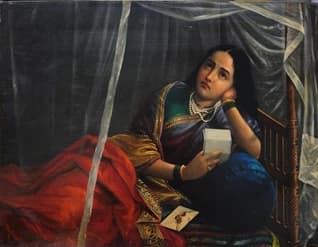
The Many Moods and Emotions in the art of Raja Ravi Varma
Celebrated among the greatest painters in India, and a visionary far beyond his times Raja Ravi Varma was known for the rich shades and energetic hues of his mythological prints and the ethereal power of his temperate paintings. Born into an aristocratic family in 1848 in the village of Kilimanoor, Kerala, Ravi Varma was the first one to blend European academic norms for the depiction of true details naturalism with a rich India-centric influence. Working with an illusionistic flair, Ravi Varma reimagined the Hindu mythological stories so deeply entrenched in the popular Indian imagination. Up until then, most of these characters were painted were flat, and the deities were recognized only by their accessories and mounts. Owing to modern realism, Raja Ravi Varma offered them a face thus humanizing them. And many lovely episodes from the Hindu epics came to life, in full-bodied form, colour, and emotion that were palpable. In a unique fusion and intermingling of light and shadows by using a perspective that added depth to his paintings, the artist traversed through disparate moods and emotions. His paintings reverberate with a zest to a celebration called life. This is why his paintings had trees adorned with fruits and flowers, and waters made more mesmerising with the various hues. Last but not least were the painting’s subjects themselves. The longing in the eyes made it seem that they would blink and come out of the painting any moment now. Disappointed, 1906 It was a remarkable shift from the type of art that was painted then. Now the eyes expressed a longing as the folds of sari fluttered, the jewels that generously adorned his subjects shimmered in a perceived angle of light - and Virahotkhandita Nayika was born. According to the classical convention, one way of recognizing ‘the grieving woman who is separated from her beloved' is through her open, unbound hair. And this is how one sees the woman portrayed here - unhappy after receiving a letter from her lover. In an image depicting the relationship between a friend and the heroine, Chitralekha paints the picture of Aniruddha, the Prince (in this case the Vaishnava deity Krishna) who stole heroine Usha’s heart. Ravi Varma titled this Chitralekha not only because that is the name of Usha’s friend, but because Chitralekha means someone who is as stunning as a painted image. In this case, the friend could really be the heroine’s own conscience. It sings a soliloquy by the grieving Nayika, one who is in separation. At that moment, Chitralekha conjures up his face in a painting. Chitralekha thus transforms into Usha’s own conscience. Chitralekha, 1890 Ravi Varma was aware of the narrative and context of the epic. Hence, he could visualize these narratives in his mind and put them on the canvas. He did not conform to set standards of following a painting theme as per the story. He was known to alter the mood and theme as per what he was commissioned or as an innovative inspiration. The classic scene of Lord Rama breaking Lord Shiva’s bow to marry Sita is legendary, for it was a precursor to the war between Lord Rama and Ravan. Varma painted the scene to show anguish on the character’s faces to mark this future event. Rama Breaking The Sacred Bow Of Siva Before His Marriage To Sita, 1906 Rama, Sita and Lakshmana Crossing The Sarayu, 1906 From one of longing and a high octane drama to a state of absolute bliss. This is a painting of Rama, Sita and Lakshana Crossing The Sarayu on their way to exile. To depict Sita's contentment when she was with her husband Rama, Ravi Varma portrayed her elaborately dressed, a peaceful visage, and her hair bound in a bun. The Stolen Interview, early 20th century If we look closely at the two characters in The Stolen Interview, we may think that they are meant for each other. It shows how two people in love conducted themselves back in those days. We see the man looking at the female, while the lady pretends to be busy with a flower in her hand. But their presence in such close proximity makes us believe that they consider each other their soulmate. The role of the flower is as symbolic in this painting as it is in most of the other paintings of Varma. The rose depicted here symbolizes eternal love. The female character has draped a simple yet elegant gold-bordered saree. The pearl jewellery she adorns around her neck is meant to tell us that she comes from an affluent household. The light is shown to come inside from out, showcasing that we, the viewers, are witnessing a private moment as complete outsiders. Yashoda and Krishna, ca. 1911 In this painting, one finds the zenith of motherly love, Vatsalya Bhava as the infant Krishna is hugging his mother Yashoda and is holding a cup in his tiny hand. His cherubic face pressed close to his mother as he begs for some fresh milk while she is milking the cow. At this moment, both the mother and the son are at their intimate best. Yashoda’s glance reveals her ecstatic joy of the nearness of her baby, whose demand she enjoys and fulfills grudgingly. pestering demand of her child. These characters are the protagonists of a historic moment from a classical text, were intended to be noble, heroic, momentous, and emotional in the most human way. These gods, goddesses, noblemen, and women left an indelible impact on art, religion, society, and aesthetics as they democratized art, perhaps groundbreaking in the history of the Indian art movement.
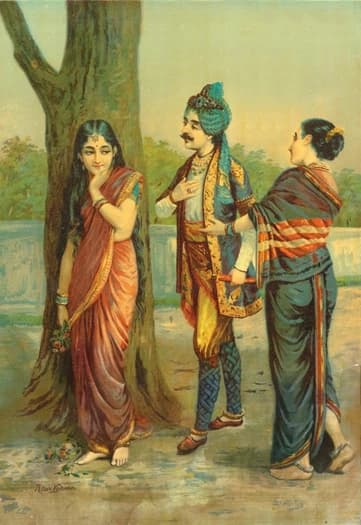
How Madalasa met Rutudhwaja - A Raja Ravi Varma Lithograph
Though the battle is still on between the supremacy of word and image, the power of a visual representation and its psycho-social immediacy when compared to the written text is undeniable. A prolific artist, Raja Ravi Varma’s paintings and oleographs of religious and mythological subjects and paintings from various classical and literary sources helped uncover many tales and stories that were hitherto unknown. Prior to Raja Ravi Varma, these characters were part of complicated hagiographies and mythological genealogies with their biographies (both historical and mythical) restricted to a few learned elites. The opening of the Ravi Varma Fine Art Lithographic Press in 1894 further democratised the patronage, consumption and reception of these images leaving a tremendous impact on religion, society and aesthetics. One such unforgettable work is Madalasa Rutudhwaja, a scene depicting a marriage proposal made by the king of Kashi Rutudhwaja to Madalasa. Markendeya Purana describes Madalasa as the most ideal and learned woman. Theirs was a unique love story full of drama, and the scene depicted in the Raja Ravi Varma paintings and subsequent print is much like a theatrical tableau. As the story goes, a demon by the name of Patalaketu was infatuated with Madalasa and at the same time, he was also tormenting rishi Galava, a sage of highest merit. One day, the demon abducted Madalasa in the hopes of ultimately winning her over. Galava, in frustration, looked towards the heavens when a divine horse appeared in the sky that had the ability to travel a thousand yojanas in a single day. The sage received the horse and gifted it to Rutadwaja who rode the horse and killed the demon Patalaketu. Thus, the heroic and noble king Rutudhwaja married the beautiful Madalasa by killing Patalaketu. This print from the Ravi Varma Press is derived from a painting by Raja Ravi Varma that depicts the courtship of Madalasa and Rutudhwaja. The print is also called “A Proposal of Marriage.” The lithograph shows a triumphant Rutudhwaja seeking Madalsa’s hand in marriage, as she coyly faces away from him. Being the fiercely independent and intelligent woman that she was, we witness a rare moment in this composition, where the Nayika (heroine) is keenly pondering over the Nayaka’s (hero) proposal instead of readily agreeing to it. Madalasa’s shy reluctance is visible in her gesture as she touches her cheek to deeply think over Rutudhwaja’s question. Her need for solitude is indicated by her body which is turned away from Rutudhwaja as she stands slightly further away. She is looking away neither seeing her suitor nor the viewer indicates that she is taking her time. Of no ordinary lineage, Madalasa was the daughter of a Gandharva (celestial being) by the name of Vishvavasu. She was believed to be a Brahmavadini, a female expounder of the highest philosophical knowledge. Madalasa, dressed in all precious finery - a red and gold silk saree, bejewelled headpiece, bangles and earrings, her lustrous hair left untied; she holds a bouquet of flowers, perhaps a gift from Rutudhwaja ahead of his proposal. Next to her, Rutudhwaja too appears resplendent as a Maharaja dressed in a brocade and velvet jacket, a silk shirt and sash tied around his waist, cross-stitched and gold-coloured jodhpurs, and leather jutis. His royal status is further accentuated by a bejewelled turban complete with a feathered sarpech (aigrette), gold and emerald necklaces, thick anklets made of gold and the sword hidden inside a velvet sheath. Raja Ravi Varma, true to his artistic genius introduces us to these two fascinating characters but also manages to beautifully narrate their stories in a simple composition bearing merely three characters and the gorgeous landscape behind them. It was as if Ravi Varma took it upon himsewlf to prove the adage “a picture is worth a thousand words” right… With his paintings and oleographs not only did the iconic painter give these characters a face and a personality, but he also immortalised these subjects in the minds of the people for eternity. RtistiQ brings to you the Raja Ravi Varma Phygital NFT art auction that will be held between the 28th- 31st July’22. Don’t miss out and collect them all by clicking here. https://art.rtistiq.com/en/auction/raja-ravi-varma-nft-drop2/lots Ravi Varma, Madalasa Rutudhwaja, Ravi Varma Press Picture Depot Image courtesy: Raja Ravi Varma Heritage Foundation
ARTICLES ON ART INSIGHT

ART INSIGHT
How to Tell a Lithograph from a Painting: A Comprehensive Guide
Art enthusiasts and collectors often come across various forms of visual art, including lithographs and paintings. While both mediums have their own unique appeal, it is important to understand the differences between them. This article aims to provide a comprehensive guide on how to differentiate between a lithograph and a painting, considering their techniques, materials, and characteristics. By gaining insights into these key factors, you'll be equipped with the knowledge to identify and appreciate these art forms more effectively. Understanding Lithographs A lithograph is a type of printmaking technique that involves the process of drawing or painting on a stone or metal plate. It is based on the principle of oil and water repelling each other. The artist creates an image on the stone using specialized tools, and then applies ink to the stone's surface. The ink adheres to the image while being repelled by the wet areas, and a piece of paper is pressed onto the plate to transfer the image. A more detailed article on Lithographs can be referenced in the article What Is A Lithograph. Analyzing Painting Techniques Painting, on the other hand, involves the application of pigments onto a surface, typically canvas, using various tools like brushes, knives, or even fingers. Paintings can be created with different types of paints, such as oil, acrylic, watercolor, or gouache. Artists have greater freedom to manipulate the paint, creating textures, layering colors, and incorporating various brushstrokes, thereby resulting in a unique and original piece of artwork. There are a few key differences between lithographs and paintings that can help you tell them apart. Paper: Lithographs are typically printed on high-quality paper, such as rag paper or watercolor paper. Paintings, on the other hand, can be painted on any type of paper, including newsprint, canvas, or wood. Ink: Lithographs are printed with ink that is specifically designed for lithography. This ink is water-based and has a high viscosity, which means that it is thick and does not flow easily. Paintings, on the other hand, can be painted with any type of paint, including oil paint, acrylic paint, or watercolor paint. Printing process: Lithographs are printed using a process called intaglio printing. This process involves pressing the plate against the paper in a very controlled manner. Paintings, on the other hand, are painted by hand, and there is no such control over the application of paint. Texture: Lithographs typically have a smooth, even texture. Paintings, on the other hand, can have a variety of textures, depending on the type of paint and brushstrokes used. Signature: Lithographs are typically signed by the artist. Paintings, on the other hand, are not always signed. Examining the Surface One of the key ways to differentiate between a lithograph and a painting is by examining the surface closely. Lithographs typically have a flat, smooth texture with even ink distribution. Due to the nature of the printing process, the lines and colors in lithographs tend to be more uniform and consistent. In contrast, paintings often exhibit varied textures, visible brushstrokes, and an overall three-dimensional quality. The presence of texture is a strong indicator of an original painting. Inspecting the Signature Another important aspect to consider is the presence of an artist's signature. In most cases, lithographs are signed in pencil, usually at the bottom margin, while paintings are typically signed in paint directly on the artwork itself. Examining the signature can provide valuable insights into the authenticity and origin of the piece. Additionally, lithographs may have edition numbers or impressions indicating the total number of prints made from the original plate. Assessing the Color Saturation Color saturation is another distinguishing factor between lithographs and paintings. Lithographs tend to have more consistent color saturation throughout the print, with an absence of subtle variations that are commonly seen in paintings. Paintings, on the other hand, often exhibit subtle color shifts, gradients, and nuanced tonal variations, showcasing the artist's hand in mixing and applying the pigments. Considering the Frame and Glass The framing and glass used can also provide clues about whether you're looking at a lithograph or a painting. Paintings are usually framed with a mat and glass, which helps protect the artwork and enhance its presentation. In contrast, lithographs are typically framed without glass, as the glass can cause unwanted reflections and interfere with viewing the image. Moreover, lithographs are often mounted directly on the backing board to prevent any damage caused by the pressure of the glass. Conclusion Distinguishing between a lithograph and a painting requires a keen eye and understanding of the key differences in technique, materials, and characteristics. By examining the surface, signature, color saturation, and framing, you can confidently identify whether you are looking at a painting or a Lithograph.
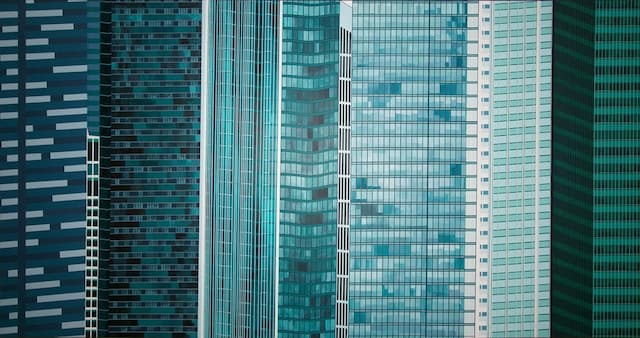
ART INSIGHT
Singapore Art and Artists: Exploring the Rich Cultural Tapestry and Creative Expression
Singapore is a vibrant city-state that has a thriving arts and culture scene. Over the years, Singapore has seen the emergence of numerous talented artists who have made significant contributions to the local and international art scene. In recent years, the art scene in Singapore has experienced significant growth and development, further solidifying its position as a vibrant cultural hub. Here's a glimpse into Singapore's art and artists: Art Movements in Singapore: Compared to European and other Asian counterparts, Art is relatively young in Singapore and driven mainly by the many cultures and traditions that make up Singapore society. What makes Singaporean Art more distinct is the merging of Chinese, Malay and European Art forms with a blend of localised cultural heritage, indigenous beliefs and popular practices in Singapore. Here is an overview of the key periods and milestones in the history of visual art in Singapore: Early Art Influences (Pre-19th Century): Before the 19th century, Singapore was primarily a trading port, and the cultures of the Malay Archipelago, China, India, and the West predominantly influenced art. Traditional art forms, such as batik, sculpture, and calligraphy, were practised by local artisans. Colonial Influence (19th-early 20th century): The arrival of British colonial rule in the 19th century brought Western influences to Singapore. European artists and art teachers introduced academic art practices, such as oil painting and portraiture, to local students. Notable artists during this period include Raffles Institution founder Sir Thomas Stamford Raffles and his wife, Sophia Raffles. Nanyang Style and Cultural Identity (mid-20th century): In the 1950s, a significant art movement known as the Nanyang Style emerged in Singapore. Led by four master artists of the time, Liu Kang, Chen Wen Hsi, Georgette Chen and Cheong Soo Pieng, this movement combined Chinese ink painting techniques with Western art styles, creating a distinctive fusion. The Nanyang Style was a form of cultural expression exploring the identity of the Southeast Asian region and its people. Modern Art Society (mid-20th century): In the 1960s, the Modern Art Society was established, advocating for modern art practices and promoting local artists. This period marked a shift towards experimentation and exploring abstract and conceptual art forms. Artists like Lim Yew Kuan and Anthony Poon were instrumental in driving the development of modern art in Singapore. Contemporary Art and Global Recognition (late 20th century-present): In the late 20th century, Singapore's art scene continued to evolve and embrace contemporary art practices. The opening of institutions like the Singapore Art Museum (SAM) in 1996 and the National Gallery Singapore in 2015 provided platforms for local and international contemporary artists. Singapore's participation in international art events, such as the Venice Biennale and the Singapore Biennale, further propelled its global recognition. Most Notable Artists of Singapore Singapore has been home to many prominent Artists continuously gaining International reputations. Here are some of the most notable and significant artists from the city-state of Singapore Georgette Chen (1906-1993) was a Chinese-born Singaporean painter known for her realistic portraits and landscapes. She is considered one of the pioneers of modern art in Singapore and a key figure of the "Nanyang School" of Art. She had spent much of her early life in China, France and New York, before making Singapore her home in the year 1954 to spend later years of her life. GEORGETTE CHEN, BOATS AND SHOPHOUSES , (credit: Sotheby's) Chen Wen Hsi (1906-1991) was a Chinese-born Singaporean painter known for his lyrical landscapes and portraits. Similar to other prominent artists Chen Wen Hsi, had spent a good part of his life in China before making Singapore his permanent home. He along with four other prominent artists founded the Nanyang Style of Painting in the year 1953, creating a watershed moment for the Singapore Art scene. In 1964 he was awarded with the "Public Service Star" award. One of his paintings "Two Gibbons Amidst Vines", addorns the back of every $50 note of Singapore. The gibbons are there not only to beautify the note but they also signify a great artist who contributed his entire whole life to the art world. Cheong Soo Pieng (1917-1983) was another prominent Chinese-born Singaporean painter known for his abstract paintings. He along with Chen Wen Hsi, Georgette Chen and Liu Kang founded the Nanyang style of art, one of the most important movements of Singapore's cultural History. After migrating to Singapore in 1946, he took up Art teaching at the Nanyang Academy of Fine Arts, and began his fervent amalgamation of Western and Chinese pictorial styles. Best known for his stylized depictions of Malay and Balinese women, he worked in a unique aesthetic that blended Hindu, Chinese, and Modernist European influences. Lim Tze Peng (born 1921) is a Singaporean painter known for his Chinese ink paintings. He is considered one of the most influential artists of his generation in Singapore. His masterpieces have been exhibited in many local and international exhibitions and prominent art centers in Singapore, including the Singapore Art Museum and Nanyang Academy of Fine Arts.. Hundred and two years old Mr Lim currently is the oldest living Artist of Singapore and was awarded the Cultural Medallion in 2003 for his vast contributions to the Art and Culture of the Country. LIM TZE PENG (courtesy South China Morning Post) Amanda Heng (born 1951): Amanda Heng is a contemporary artist known for performing art and installations. She often addresses issues of gender, identity, and social norms in her works and has exhibited her art internationally. She rose to pominance in the 1990's and is considered a pioneer of Performance Arts in Singapore. She is among the first Singaporean Artists to win the distinguished Benesse Prize and also awarded Cultural Medallion for Visual Arts in 2010. Among the many firsts that she brought to the Art scene in Singapore, includes the founding of the Artists Village in 1988 and then later in 1999 she formed the Women in The Arts (WITA) Collective, the first Artists run collective in Singapore. Tan Swie Han (born 1943) Born in Indonesia Tan Swie Han is a Singaporean multi-disciplinary Artist who migrated from Indonesia in 1946 and is known for his Chinese calligraphy and Contemporary Art Sculptures. He is also distinguished as being the most expensive artist in Singapore after he sold his painting "Moon is Orbed" for S$3.7M in the year 2012 and later again broke his own record by selling his ink on rice-paper artwork "Bada Shanren" for S$4.4M. Tan Swie Han (courtesy Straits Times) Yeo Shih Yun (born 1976): Yeo Shih Yun is a Singaporean artist known for her abstract ink paintings. She combines traditional Chinese ink painting techniques with contemporary approaches, creating bold and expressive artworks reflecting her experiences and emotions. Jane Lee (born 1963): Jane Lee is a contemporary artist known for her experimental approach to painting. She often uses unconventional materials such as epoxy paint and polyurethane foam to create textured and multi-dimensional artworks that challenge traditional notions of painting. Lee has toyed with the painting structure to create rich and tactile abstract works that frequently combine two into three dimensions. These are just a few examples of the many talented artists from Singapore who have significantly contributed to the local and international art scene. The art scene in Singapore continues to evolve and grow, with new artists constantly emerging and pushing the boundaries of artistic expression. Head on to our curated collection Inspired-By-Singapore with a selection of works created by Artists worldwide that could illustrate different sides of Singapore's cultural diversity. Part of this collection is a selection of paintings by the Australian artist Dean O'Callaghan painted and inspired by Singapore's cityscapes and exclusively available on RtistiQ.

ART INSIGHT
Exploring the Intricate Techniques of Islamic Art
Islamic art is a rich and diverse artistic expression shaped by centuries of cultural and religious influences. From calligraphy to geometric patterns, this guide explores Islamic art's various styles and techniques and how they have evolved over time. What are Islamic Art styles and techniques in the contemporary art market? Islamic Art encompasses various styles and techniques, some of which have been adapted and incorporated into contemporary art markets. Here are some examples: Calligraphy: Islamic calligraphy is one of the most recognisable art forms in the world. It involves the writing of Quranic verses or other Islamic phrases in a decorative way. Contemporary artists have experimented with this style by incorporating it into paintings, sculptures, and installations. Calligraphy is also used to decorate buildings, textiles, and other objects, and is often combined with other forms of Islamic art, such as geometric patterns and floral motifs. The beauty of calligraphy lies in its ability to convey meaning and emotion through the careful arrangement of letters and words. Geometric patterns: Geometric patterns are common in Islamic Art and are often used to decorate mosques and other religious buildings. Contemporary artists have also incorporated these patterns into their work, creating modern pieces rooted in Islamic tradition. Some common geometric shapes used in Islamic art include circles, squares, triangles, and stars. These shapes are often combined to create intricate and mesmerizing patterns that are both beautiful and meaningful. Miniature painting: Miniature painting is a traditional Islamic art form that involves creating small, detailed paintings on paper or other surfaces. Contemporary artists have continued to use this technique, often with a modern twist, creating works that are both intricate and innovative. Metalwork: Islamic metalwork is known for its intricate designs and detailed craftsmanship. Contemporary artists have continued to use metalworking techniques to create modern pieces that are both functional and aesthetically pleasing. Ceramics: Islamic ceramics are often decorated with intricate patterns and designs. Contemporary artists have continued to use this technique, creating modern ceramics that are both beautiful and functional. Islamic art styles and techniques have a rich history that inspires contemporary artists worldwide. By blending traditional Islamic techniques with modern styles and materials, these artists are creating a new and exciting form of Art that celebrates both the past and present. The influence of nature and floral motifs Nature and floral motifs are also commonly found in Islamic art. These motifs are often used to symbolize growth, renewal, and the beauty of the natural world. Islamic artists often use stylized versions of flowers, leaves, and vines in their designs, incorporating them into geometric patterns or using them as standalone elements. The use of nature and floral motifs in Islamic art reflects the importance of nature in Islamic culture and the belief in the interconnectedness of all living things. Working across various disciplines, Mobeen Akhtar details her fondness for arabesque by using natural pigments extracted from minerals, rocks and earth as she aims to practise the traditional methods so they may be recognised and enjoyed today, as they were in the past. The role of color and symmetry in Islamic art Color and symmetry are two important elements in Islamic art. The use of vibrant colors, such as blues, greens, and reds, is common in Islamic art and is often used to create a sense of harmony and balance. Symmetry is also a key feature of Islamic art, with many designs featuring intricate geometric patterns that are perfectly balanced on both sides. This symmetry is believed to reflect the order and balance found in the natural world and is a reflection of the Islamic belief in the unity and harmony of all things. Is Islamic Art a religious-only Art? Islamic Art is not solely religious but strongly connects to the Islamic faith and culture. Islamic Art encompasses various artistic forms and styles, including calligraphy, geometric patterns, miniatures, textiles, ceramics, metalwork, and architecture. Multiple cultures and regions have influenced these art forms throughout Islamic history and have been used for religious and secular purposes. Islamic Art can be found in various settings, from religious spaces like mosques and madrasas to secular areas like homes, palaces, and public buildings. In addition, Islamic Art has been appreciated and collected by people of various faiths and cultures throughout history. While Islamic Art often incorporates Islamic themes and motifs, it is not limited to religious subjects. Many Islamic artists throughout history have drawn inspiration from the natural world, human figures, and other non-religious subjects. In contemporary Art, Islamic art styles and techniques continue to inspire artists of all backgrounds and beliefs. By blending traditional Islamic techniques with modern styles and materials, these artists are creating a new and exciting form of Art that celebrates both the past and present. Is Islamic Art only practised by Muslims? Islamic Art has its roots in the Islamic faith and culture, but it is not limited to only Muslims. Islamic Art encompasses various artistic forms and styles, including calligraphy, geometric patterns, miniatures, textiles, ceramics, metalwork, and architecture. Multiple cultures and regions have influenced these art forms throughout Islamic history, and they have been appreciated and practised by people of different faiths and backgrounds. Many non-Muslim artists and artisans have contributed to the development of Islamic Art throughout history. In medieval Spain, for instance, Christian and Jewish artists worked alongside Muslim artisans to create some of the most stunning examples of Islamic Art and architecture. And in modern times, many contemporary artists and designers from diverse backgrounds have been inspired by Islamic Art and its techniques, incorporating them into their works. Furthermore, many Islamic art forms have been used for religious and secular purposes. Islamic architecture, for example, is often used for public buildings and private homes, regardless of the faith or background of the owner. Similarly, Islamic calligraphy and geometric patterns are often used in various artistic and decorative contexts, from book design to interior decoration. Final Thoughts! In conclusion, Islamic art is a form of art that is enjoyed by people of all backgrounds, cultures, and faiths. Its beauty and significance can be appreciated by anyone with an appreciation for art and culture. Head on to a very special collection of Islamic Art from Artists across different part of the world on RtistiQ - Cultural festivity Art Collection

